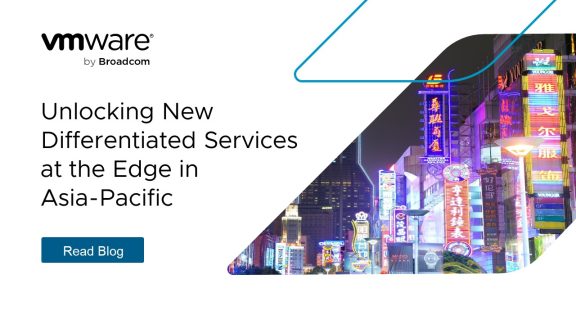Organizations in every industry are adopting new data-driven digital tools to transform their operations. But increasingly, the operations they want to transform happen far from traditional data centers at the enterprise edge, where connections get spotty and cloud resources constrained—if available at all. Now, communication service providers (CSPs) can offer an answer: the software-defined edge (SDE).
For years, VMware by Broadcom has been helping CSPs cloudify their networks to unleash new agility and automation for their customers and their own operations. That journey starts in core networks, where solutions like VMware Telco Cloud Platform turn traditional telco infrastructure into a flexible horizontal platform, with visibility and cloud-smart automation end to end. More recently, we brought cloud flexibility and programmability to radio access networks with VMware Telco Cloud Platform RAN. Now, we’ve unveiled a new solution that extends the programmable CSP network—and the cloud transformation it enables—all the way out to distributed customer locations with VMware’s software-defined edge portfolio.
Simply put, SDE is just another way of saying, “digital infrastructure for running workloads at distributed locations.” It’s a way for CSPs to bring flexible real-time cloud capabilities out to dispersed customer edge sites, close to where endpoints generate and consume data. And it applies lessons from software-defined wide-area networks (SD-WAN) to do it in an efficient, automated way.
By 2025, Gartner predicts that more than half of enterprise-managed data will be created and processed outside the data center or cloud—in other words, at the edge (“The Gartner report Hyperscalers Stretching to the Digital Edge, 24 July 2023”)—but today, most cloud and enterprise applications are still centrally administered. This imbalance creates a unique opportunity. Businesses that can collect, analyze, and act on data directly at distributed locations can gain a significant competitive advantage. And CSPs that can deliver real-time edge capabilities have an opportunity to grow their enterprise service portfolio and play a larger, more valuable role in their customers’ business.
Reimagining the Enterprise Edge
Enterprises are adopting data-driven operating models that use real-time applications (video inference, factory automation, and many others) to optimize every aspect of business operations. To succeed, however, they need the flexibility and intelligence of the cloud at distributed locations. CSPs that can deliver the next-gen edge can play a central role in the next wave of their customers’ digital transformation. But they can’t do it with yesterday’s one-size-fits-all managed services. They need new kinds of customizable, application-aware delivery models, and the ability to extend those models wherever enterprises need them.
“Edge” implies both location and functionality, both of which present challenges when relying on remote, centralized data centers. For some real-time applications (such as robotic automation, autonomous vehicle control, or extended reality), routing data back through the data center would introduce too much latency. Others (like “AI vision” video monitoring) generate so much data, the cost to transport and process it all in a centralized data center or public cloud would be exorbitant.
The answer is to bring cloud intelligence out to the distributed locations that need it, but this is easier said than done. Edge locations—whether owned by the CSP or an enterprise customer—can vary greatly. A local data center, a customer factory, and a RAN cell tower could all act as “edge” sites but will have very different resources available depending on size, location, connectivity, and level of onsite support. It’s incredibly difficult to centrally manage edge services if each location requires specialized hands-on provisioning and management. The good news is, this problem is solvable.
When it comes to connectivity—ensuring that distributed locations have the right network and security to meet local requirements—many enterprises already use a software-driven network overlay in the form of SD-WAN. Now, we just need to apply the same intelligent overlay model to manage distributed workload processing too. And no one is better equipped than CSPs to do it.
Inside the Software-Defined Edge
To unlock the transformative value of next-gen edge applications, an SDE framework provides three overarching capabilities:
- Right-sized infrastructure: Edge workloads need to run on hardware that is smaller, to fit in any space from a back office to an offshore oil platform, and can be secured in inherently un-secure physical environments. Virtualization is key to “shrinking the stack,” but edge hardware requires a different approach than data center virtualization. While virtualization in the data center is great for scaling diverse workloads, edge workloads are specialized and driven by specific hardware and industrial networking requirements, some requiring real-time response. These special edge workloads are being virtualized for flexibility, but they also require a platform that prioritizes hardware efficiency and performance.
- Zero-touch orchestration: As enterprises, industry, and service providers launch new digital innovations at dispersed locations, their sprawling IT environments grow more challenging to manage and control—especially at sites with minimal IT resources. SDE replaces traditional push-based management with an intelligent overlay across the distributed network. Using zero-touch provisioning and pull-based orchestration, edge applications can request network and computing resources, and SDE automatically delivers what each workload needs, when it needs it. From providing access to Github repositories to enabling real-time configuration and updates, applications at the edge act as their own administrators to enable even the most high-performance use cases.
- Programmable network: SDE links distributed edge sites with the telco network to allow applications to program the network directly. It identifies the latency, throughput, and other characteristics that each workload needs, and provides the optimal connectivity – whether wired, terrestrial, or non-terrestrial – to enable it, in real time. Using open APIs accessed through the SDE intelligent overlay, enterprises will be able to dynamically program the telco network to create new network slices. Applications will be able to program slices with dedicated network resources, prioritized traffic management, and embedded security to meet their unique performance requirements, in real time.
Most enterprises already work with a CSP partner to provide the physical links to their distributed edge locations. Now, by augmenting WAN connectivity with new compute and orchestration tools, CSPs can create a comprehensive SDE offering to deliver even more advanced digital capabilities wherever customers need them.
VMware SDE components
As a longtime partner to both CSPs and enterprises, VMware can provide everything CSPs need to deliver and benefit from enterprise SDE solutions. VMware can provide the full infrastructure stack for connecting CSPs to their customers’ distributed edge environments, while managing everything as a flexible software-defined overlay. VMware’s SDE solution combines:
- VMware Edge Compute Stack provides the automated right-sized compute infrastructure for operational technologies at the edge. This edge-optimized runtime and orchestration platform enables frictionless management of distributed applications and infrastructure across thousands of sites. Its pull-based architecture allows for simple remote lifecycle management of edge applications.
- VMware VeloCloud SD-WAN links distributed edge sites and ECS infrastructure with the programmable CSP network. It controls the underlying CSP-provided WAN links including 5G / LTE fixed wireless access, satellite, broadband, MPLS, and other connectivity options at each site, bundling them together into a programmable intelligent overlay. On top of secure connectivity, it provides traffic prioritization, remediation, problem detection, and more. VMware VeloCloud SASE, secured by Symantec, is a single-vendor SASE solution that consists of best-in-class VeloCloud SD-WAN capabilities and Security Service Edge (SSE) services from Symantec for secure, reliable, and optimal branch and edge access. VMware VeloCloud SD-Access provides simple, secure, and cloud-managed zero trust network access for remote users and devices anywhere, anytime.
- VMware Edge Cloud Orchestrator provides single-pane of glass management across SD-WAN, SASE, SD-Access, and distributed compute infrastructure and workloads. It leverages advanced analytics to track the health and status of all edge resources to provision, connect, and secure the workload with the right set of policies automatically to meet real-time application requirements. VMware Edge Cloud Orchestrator also simplifies lifecycle management of distributed edge resources, including enabling CSPs to create site profiles once and scale them out to thousands of locations.
- VMware Telco Cloud Platform provides the programmable network foundation for SDE. It transforms the CSP network into a flexible horizontal platform across the core and RAN with cloud-smart automation, consistent service management and orchestration, and multi-layer visibility end to end. The platform brings the agility of virtualization and flexibility of cloud-native architectures to CSP operations. By speaking the same cloud-native language as enterprise software, it can enable enterprise applications to directly program the network for the resources they need, in real time, via open network APIs.
Capitalize on the edge opportunity
SDE dramatically expands the possibilities to exploit new digital capabilities at the edge—capabilities that are becoming mission-critical for any business seeking to lower costs and stay ahead of the competition. No one is better positioned than service providers to help enterprises take advantage of it.
CSPs bring extensive experience managing vast networks at scale, along with an unmatched physical footprint that extends from remote customer locations to the cloud. By working with a CSP, enterprises can also focus on using new edge capabilities under a “Lean IT” model, while their CSP partner manages the entire distributed SDE environment. CSPs can bundle SDE offerings with connectivity, security, collaboration, managed Wi-Fi, and other enterprise offerings and deliver everything as a single solution, with a single monthly bill.
For service providers, SDE provides an opportunity to build on existing capabilities and customer relationships, and create new digital offerings that meet a critical enterprise need. CSPs can deliver more differentiated programmable capabilities, even as they modernize their own networks. And they can play a more valuable role in their customers’ businesses, higher up the enterprise application stack.
It’s a win-win for everyone participating in the emerging edge ecosystem. And there’s no better time to get started.
To learn more about how you can tap into the next-generation edge to deliver new innovation and value to enterprise customers, contact us on our website.








